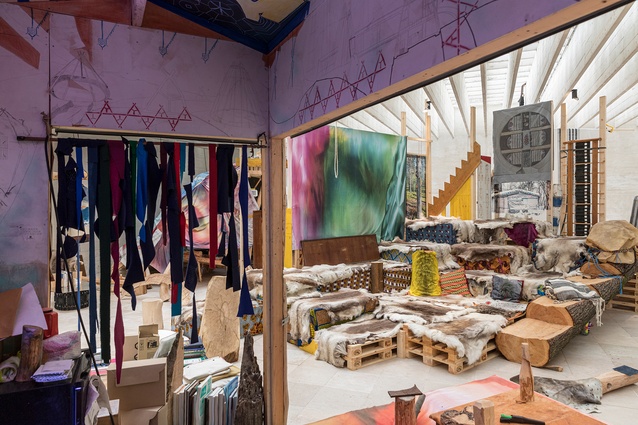
From Spmi to Aotearoa: Connecting architecture and craft across the hemispheres
architecturenow.co.nz
Click to enlargeThe Sami Architecture Library by Joar Nango and collaborators at the Nordic Countries Pavilion. Image: Laurian Ghinitoiu (2023) 1 of 9The Sami Architecture Library by Joar Nango and collaborators at the Nordic Countries Pavilion. Image: Supplied 2 of 9The Sami Architecture Library by Joar Nango and collaborators at the Nordic Countries Pavilion. Image: Supplied 3 of 9Joar Nango and Girjegumpis collaborators at the inauguration of Girjegumpi_The Sami Architecture Library by Joar Nango and collaborators at the Nordic Countries Pavilion. Image: Supplied 4 of 9Joar Nango and Girjegumpis collaborators at the inauguration of Girjegumpi_The Sami Architecture Library by Joar Nango and co. at the Nordic Countries Pavilion. Image: Supplied 5 of 9Conversation on Architecture in Sapmi. Image: Supplied 6 of 9Joar Nango in Girjegumpi. Image: Supplied 7 of 9Joar Nango, Girjegumpi in Jokkmokk, 2018. Image: Astrid Fadnes 8 of 9Joar Nango, Girjegumpi in Jokkmokk, 2018. Image: Astrid Fadnes 9 of 9Smi architect and artist Joar Nango and collaborators will visit Aotearoa from 18 Nov3 December, leading up to an exhibition at Objectspace opening 6 pm, Friday 29 November, and running from 30 November 202416 March 2025.Titled Building an archive of Indigenous architecture,the show is an iteration of Nangos Girjegumpi project (a nomadic Smi architectural library), which was presented at the Nordic Countries Pavilion at the 18th International Architecture Exhibition of La Biennale diVenezia.Formally trained as an architect, Joar Nangos practice includes collaborative site-specific installations and self-made publications that explore the boundaries between architecture, design and visual art. As one of only a few Smi architects, amplifying ideas related to Indigenous contemporary architecture and traditional building customs are integral to hiswork.Location:Objectspace, 13 Rose Road, Tmaki Makaurau, Auckland Opening: 6 pm Friday 29 November Duration: 30 November through to 16 March2025Joar Nango in Girjegumpi.Image: SuppliedBeginning during his time studying architecture, Nango has collected books and materials relevant to Smi architecture and Indigenous worldviews. In 2018, these texts came to be housed in Girjegumpi, a nomadic Smi architectural library that has since travelled across Spmi, and into Europe and Canada. Within Girjegumpi, Nango offers a space for education and dialogue, addressing issues relevant to Indigenous architecture, resistance, and Indigenisation: the importance of collaborative work, consideration of resource use in urgently changing climates, locally grounded material flow and sensitive approaches tolandscapes.The Sami Architecture Library by Joar Nango and collaborators at the Nordic Countries Pavilion.Image: SuppliedAt Objectspace, Nango creates a continuation of Girjegumpi. This manifestation of the project centres on knowledge sharing and continues Girjegumpis foundations of interrogation and exchange. Prior to the exhibition opening, a group of Indigenous architects from Aotearoa, Spmi and Australia gathered to offer texts that now become part of Girjegumpi. In Aotearoa, facilitating a space to consider Mori architecture was integral to the project and marks the beginning of exchange, tautoko and awhi for the practitionerspresent.Within this exhibition, the publications, moving image from Nangos archive, textiles and ephemera create a collection emblematic of the collaborative grounding of Nangos practice. It is a gathering space, a reading room for study and a dreaming place for Indigenousimagination.The Sami Architecture Library by Joar Nango and collaborators at the Nordic Countries Pavilion.Image: Laurian Ghinitoiu (2023)Joar Nangos concept ofGirjegumpiThe title Girjegumpi is derived from two Northern Smi words: Gumpi is a mobile cabin on runners, most often pulled by a snowmobile. Girji means book. The construction of Girjegumpi draws on Smi building traditions, characterised by improvisation, pragmatism and adaptation toenvironment.Girjegumpi is a nomadic project that changes in different situations and contexts. It was exhibited for the first time as part of the Arctic Arts Festival in Harstad in 2018. It has been exhibited in Jokkmokk, Canada, Bergen, Oslo and most recently Bod. In 2023, Nango, alongside a team of collaborators presented Girjegumpi at the Nordic Countries Pavilion at the 18th International Architecture Exhibition of La Biennale diVenezia.About theartistJoar Nango in Venice, 2022.Image: Knut AserudJoar Nango is an architect and artist based in Romsa, Norway. His work is rooted in Spmi the traditional Smi territory covering the northern regions of Norway, Sweden, Finland and the Kola Peninsula in Russia. Through building, site-specific interventions, design collaborations, photography, publications and video, Nangos work explores the role of Smi and Indigenous architecture and craft in contemporary thought. Nangos work, including the long-term project Girjegumpi, is nurtured by parallel collaborations with other artists, architects, and craftspeople. Trained at the Norwegian University of Science and Technology (NTNU) in Trondheim, Nango graduated in Architecture in 2008. Since then, his work has been presented at documenta 14, Bergen Kunsthall, National Museum Oslo Architecture, Canadian Centre for Architecture,Smi Diddaguovdd (Smi Centre for Contemporary Art), andKiasma.This exhibition includes contributions from Eveliina Sarap, Magnus Antaris Tuolja,Katarina Spik Skum and Ken Are Bongo.Joar Nango: Building an archive of Indigenous architecture has been developed by Objectspace and supported byNordisk Kulturfonds Globus initiative and The Warren Trust.Follow@objectspace for information and updates onupcoming events and exhibitions in both Tmaki Makaurau Auckland and tautahiChristchurch.
0 Commentaires
·0 Parts
·270 Vue


